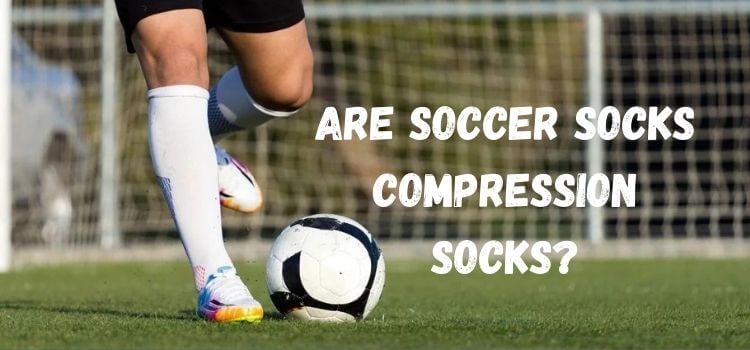As an Amazon Associate, I earn from qualifying purchases
Soccer socks are an essential part of a soccer player’s uniform, but do they also serve the function of compression socks? Let’s delve into the intricacies of soccer and compression socks to understand their roles in sports performance and injury prevention.

Understanding Compression Socks
What Are Compression Socks?
Compression socks are specialized clothing items that exert mild pressure on your legs to improve blood circulation and lessen discomfort and edema.
How Do Compression Socks Work?
Compression socks apply graduated pressure to your legs, with the most significant pressure at the ankle gradually reducing as the sock goes up your leg. This helps improve venous return, aiding blood flow back to the heart.
The Importance of Compression in Sports
Athletes have come to love compression clothing because of its potential to improve performance and recovery. Maintaining optimal blood flow can significantly enhance overall performance in sports like soccer, where agility and endurance are crucial.
Characteristics of Soccer Socks
Soccer socks, however, are primarily designed to protect the player’s legs from abrasions and support shin guards.
They are typically made from breathable materials like polyester or nylon and feature elastic cuffs to keep them in place during vigorous movements on the field.
Do Soccer Socks Function as Compression Socks?
Because they fit snugly, soccer socks give some compression but not the graduated pressure that medical-grade compression socks are intended to provide. These socks prioritize other functions, such as moisture-wicking and durability, over compression.
Benefits of Compression Socks for Athletes
Compression socks offer several benefits for athletes, including:
- Improved circulation
- Reduced muscle fatigue
- Reduced muscle fatigue
- Quicker recovery after intense exercise
- Decreased risk of injury, such as shin splints and muscle strains
Soccer Socks vs. Compression Socks: Key Differences
The primary differences between soccer and compression socks lie in their design and intended purpose. While soccer socks focus on protection and support during gameplay, compression socks prioritize enhancing circulation and aiding recovery.
Factors to Consider When Choosing Soccer Socks
When selecting soccer socks, players should consider material, fit, and cushioning to ensure comfort and performance on the field. While compression may be a secondary consideration, it’s essential to prioritize functionality over fashion.
When to Opt for Compression Socks
Athletes may wear compression socks during training sessions or matches, especially if they experience leg fatigue or swelling. However, wearing compression socks alone may not address specific soccer-related concerns like impact protection.
Common Misconceptions
There are misconceptions that soccer socks can serve the same purpose as compression socks, leading some players to overlook the benefits of proper compression gear.
Understanding the distinct roles of each type of sock can help athletes make informed decisions about their athletic wear.
The Role of Soccer Socks in Injury Prevention
While soccer socks primarily offer protection against external forces, they also play a role in injury prevention by securing shin guards and minimizing friction between the skin and footwear.
However, athletes should not rely solely on soccer socks for comprehensive injury prevention measures.
Tips for Maximizing the Benefits of Soccer Socks
To get the most out of their soccer socks, players should:
- Ensure a proper fit
- Invest in high-quality materials
- Replace worn-out socks regularly
- Use additional compression gear if needed, especially during recovery periods
Real-Life Experiences: Athletes’ Perspectives
Professional soccer players incorporate compression gear into their training and recovery routines, citing improved performance and faster recovery times.
However, individual preferences may vary, and athletes should experiment with different options to find what works best for them.
Conclusion
Soccer socks are a great way to protect and support players, but they compress less than compression socks explicitly made for soccer. Understanding the differences between the two types of socks can help athletes make informed choices about their athletic wear and optimize their performance on the field.
FAQs
Compression socks offer benefits for circulation and recovery, but they may not provide the protection and support required during gameplay. It’s best to use soccer socks specifically designed for the demands of soccer.
Though they might not provide enough stability to stop problems like ankle sprains, compression socks can help with circulation and muscle support. Proper footwear and conditioning exercises are essential for injury prevention in soccer.
Wearing compression socks for several hours after intense physical activity, including soccer matches, is recommended to aid recovery. However, individual preferences and comfort levels may vary.
Compression socks may contribute to improved performance by reducing muscle fatigue and enhancing circulation, but their impact may vary among individuals. Incorporating compression gear into a comprehensive training regimen may yield positive results.
While most people find compression socks harmless, some may find that wearing them for an extended period causes discomfort or skin irritation. Making sure it fits right is essential; if you have any questions, see a healthcare professional.
Read Our More Articles
- What to Wear to Soccer Tryouts: Tips and Tricks
- Why Do Soccer Players Wear Socks Over Their Knees? Closer Eye
- What Do Grip Socks Do in Soccer? Unraveling the Mystery
As an Amazon Associate, I earn from qualifying purchases


